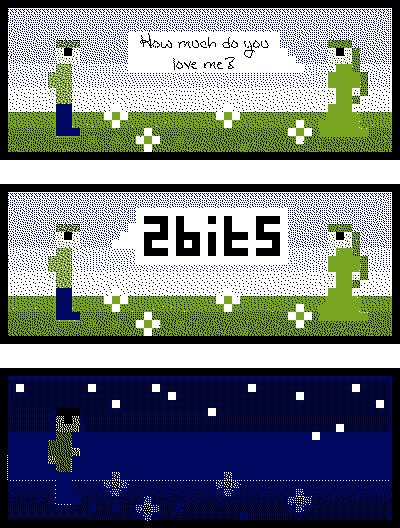» About/Submit » Archive » Authors » Search » Random » Statistics » Forum » RSS Feed Updates Tuesday, Thursday, Saturday
No. 737: Lubberly Glaums: Bits
First | Previous | 2023-10-28 | Next | Latest

First | Previous | 2023-10-28 | Next | Latest
Permanent URL: https://mezzacotta.net/itoons/?comic=737
Strip by: Jacob S
{The whole comic only uses 4 colours. Dithering is used for shading}
{A pixelated scene like a low-res computer game}
Woman: {in fancy handwritten script} How much do you love me?
Man: {in low-res pixelated block text} 2 bits
{The same scene several hours later, at night. The man stands there alone.}
The author writes:
Firstly, there’s a pun added here: “to bits” / “2 bits”.
Secondly, this comic only uses four colours, which means to define the color of each pixel, you only need 2 bits. When you’re working with a limited colour palette like this one, if you more complicated colours and shading, you use a technique of adding intentional noise known as dithering. For example, the sky in the first two panels include blue pixels within the white to make it appear light blue. Fortunately, you don’t have to do this manually; there are many algorithms that do dithering automatically. This image uses the Floyd–Steinberg dithering implemented in GIMP. GIMP also allows you to generate a quantized color palette for a specific image, which I also used.
Nowadays limited color palettes are obsolete: computers can display millions of colours onscreen at a time, and most image formats reflect this (except .GIF, but it was last updated in 1989, so you can cut it some slack), but for the few of you who are browsing iToons on some legacy system, you can rest assured that your limited color space is everyone’s limited colour space.
Finally, I spelled colo[|u]r both ways for internationali[s|z]ation.
Original Awkward Fumbles strip: 2009-05-13 / #5: "Pixels".
